10 Mature Moments in a Pixar Film

Whenever audiences think about animated films or any films in general that are rated G or PG, most people would think of these movies as being aimed primarily towards children. To an extent, that argument is valid; there are plenty of films that are geared more towards kids than adults, especially from particular studios such as Illumination Entertainment (Despicable Me) and Blue Sky Studios (Ice Age) whose films are bright, colorful, and filled with plenty of slapstick comedy to entertain the younger crowds. Granted it is not like these movies can never find an audience beyond children – there are likely plenty of adults who enjoy the likes of Minions – but these films nevertheless see their audiences as consisting mostly of children, and at times, they tend to treat them as such.
It is perhaps for this very reason why Pixar remains the king of computer animation: because their films have reached an audience that transcends any marketing demographics or notions of what constitutes a kids’ film. Sure, all of their films are rated G and PG, their animation is bright and lively, the lead characters are likeable, and they promote positive morals for children. However, Pixar has proven that just because a film is made for kids does not mean it has to be devoid of creativity or emotional depth, and the end results are films that bring surprisingly mature, bold, and sometimes complex ideas for children that offer more than any run-of-the-mill slapstick films with pop culture references and bottom of the barrel pandering.
Since the release of its first film, Toy Story, in 1995, Pixar has releases a sum total of 15 animated movies – 7 of which that have won the Academy Award for Best Animated Feature – and almost all of them have something unique to offer for kids (with the possible exception of Cars 2 which marked a rare blight from the studio). All of them focus on different subjects ranging from parenthood and marriage to more complex subjects such as inner emotions, and the incredible passion and effort behind these films has resulted in some of the finest crafted animated films ever made. To honor the studio’s impressive legacy, this list will cover in chronological order some of the most emotional, dark, touching, and mature moments that Pixar has presented in its 15-film catalog (excluding their animated shorts) and why these moments are significant to both the movies themselves and their target audience.
Just as a quick heads-up: this list covers a lot of pivotal scenes from various Pixar movies, so there will be some spoilers ahead. (In other words, if you have not seen Inside Out yet, you may want to see the movie first before reading the rest of this article.)
“When She Loved Me” (Toy Story 2)

The first entry on this list from Toy Story 2 is perhaps not only the first significant dramatic beat in Pixar’s filmography, but also one that in many ways defines why Pixar is a master at simple yet effective storytelling. In this scene, Jessie finally opens to Woody about her past with her former owner Emily, a kid who she adored as much as Woody still does for Andy. The two were inseparable during her childhood, but as Emily grew older, Jessie was all but forgotten, left to gather dust under her bed for years. When she is finally discovered by Emily again, Jessie enjoys the comfort of her owner, only to realize the heartbreaking truth that Emily is leaving her behind in a donations box, leaving Jessie to watch as her owner leaves her behind forever.
At this point in Pixar’s history, their films have been mostly lighthearted affairs. There were some dramatic moments that occurred in Toy Story and A Bug’s Life, such as the moment when Buzz Lightyear finally discovers that he is in fact a toy, but ultimately nothing too serious for kids or anything that audiences have not seen in other films before. Toy Story 2, however, provided one of the most emotionally devastating back-stories to a main character seen in an animated film. Oftentimes when something this serious comes up in something like The Lion King, it only takes one “Hakuna Matata” to lighten up the proceedings. This was the first moment for Pixar that completely pulled the carpet under audiences thinking they were going to see a film just for kids.
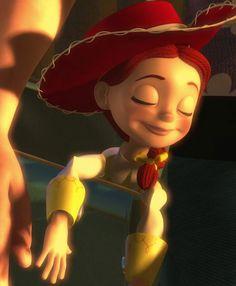
The end result is a scene that is so emotionally compelling that it actually gets just as much of a strong response from adults as it does with kids. There are several reasons why, much of which comes from John Lasseter’s brilliant execution of the sequence. Rather than using dialogue or a film score, the only sound that accompanies the sequence is the song “When She Loved Me,” which was written by Toy Story composer and songwriter Randy Newman and performed by Sarah McLachlan. The song itself is very powerful to listen to, with McLachlan’s somber voice reminiscing of the good and bad times of Jessie’s life while a melancholic piano adds to the visuals. It was somewhat unconventional for a kids’ film to use an approach such as this, but it nevertheless resonated with viewers of every age, and most people single out this scene as the best in the movie.
Of course, this all leaves a question: why did this scene about an abandoned toy leave such an impact on people? In many ways, it is because of how relatable it is. Everyone has grown up with toys at some point or another; it is a natural part of one’s childhood – something that the first Toy Story captured memorably. After seeing the life of toys through their perspective and bonding with the likes of Woody and Buzz, it is all the more heartbreaking to see Jessie’s fate because her situation is what all toys go through when their owners outgrow them. In a way, this can even apply to parenthood when parents have to watch their children grow up and leave, which makes Jessie’s back-story poignant to both kids and adults. It captures so many emotions and creates a remarkably relatable experience of growing up in just a brief 3 minutes, and the way it resonated with all age groups without sacrificing on drama or integrity makes this moment one of the notable achievements in Pixar’s filmography.
Marlin Names Nemo (Finding Nemo)
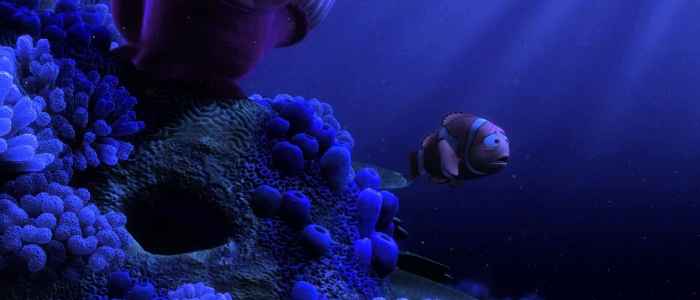
Remember how depressing the death of Bambi’s mother was in Bambi? Imagine that within the first 4 minutes of a movie, and you have the tragic opening of Finding Nemo. The death of a parent is surprisingly very common in a lot of movies – Disney itself has done it on a number of occasions – but usually they happen later in the movie, mostly around the halfway mark. In this case, however, Finding Nemo opens immediately with Marlin and his wife, Coral, moving into a sea anemone with dozens upon dozens of eggs containing their babies, only for tragedy to strike when a barracuda attacks them, knocking out Marlin and devouring Coral and all of their children. That is, all except one lone egg, which Marlin clings onto and comforts before naming the baby Nemo – a name that Coral wanted for one of her children.
As mentioned earlier, the death of a parent is fairly common even in kids’ films, but this is possibly one of the first to focus on it from the perspective of one of the parents, not just the child. This focus also carries over into the rest of the movie, as Marlin becomes extremely overprotective of his son fearing that he will lose him to the dangers of the ocean, which eventually leads into Nemo being captured by a marine diver and Marlin traveling across the ocean to save him. Normally films aimed at children present more focus on the younger characters (who are often the leads) in order to appeal to younger audiences and also present good morals. While this film still does both of those things, it also places more emphasis on the father and, more importantly, the drama that occurs when he suffers a tragic loss and tries to do everything in his power to prevent it from happening again.

Much like what Pixar has done again and again in their films, the drama and conflicts in Finding Nemo are immediately relatable, which is what gives scenes such as this their emotional weight. Aside from cutting to black when Marlin is knocked out to avoid showing anything too traumatic for kids, the tone of the scene is very dark, with the lighting suddenly becoming pitch black and the environment cold and empty, save for the tiny bright light that is Nemo’s orange egg lying in the sand. The tragic death of Coral and almost all of Marlin’s children is sadly an occurrence that is also possible in real life when a kid loses someone very close to them at a young age, and even for those who have not experienced it, the scene gives so much weight to the loss and Marlin’s attachment to the only surviving child that it would be almost impossible not to sympathize with him.
This may not sound like too much of a big deal for a kids’ movie, but considering how few of them actually place just as much emphasis on the father as it does on the son, it not only presents strong morals to both groups, but also possibly helps bring them together. Finding Nemo is first and foremost a father-son journey, and the drama comes from the film’s ability to develop both sides and make them identifiable for kids and adults. It is for this reason why Finding Nemo is still among one of Pixar’s greatest achievements, and the opening scene in particular helps to establish all of these elements that would define the rest of the movie, even if it requires showing something dark for kids.
Family Drama (The Incredibles)
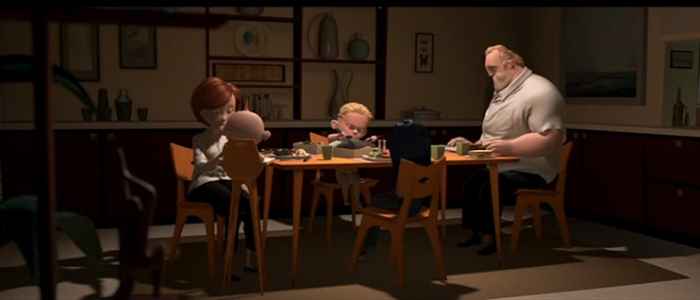
While The Incredibles is not the first Pixar film to have human characters, it is significant in that it is the first film by Pixar where all of the leads are people instead of inanimate objects, monsters, or animals. That may not sound like much on paper, but one of the best qualities of Brad Bird’s The Incredibles is the family dynamics, as the story focuses on a family of superheroes who end up having to come out of hiding to save the world. The setting of The Incredibles is in itself a bit more mature than your average superhero movie (think a much more kid-friendly version of Watchmen), with numerous lawsuits and financial problems regarding superhero activity resulting in the Superhero Relocation Program being passed, which provides financial support to relocate superheroes under new identities in return for them to never perform any superhero work again.
The impact of the Superhero Relocation Program has some interesting effects on both Mr. Incredible and his family. With Mr. Incredible no longer able to relive the glory days, he has to settle for a terrible job at an insurance company while also laying low and raising a family of kids, who also have their own superpowers (except for Jack-Jack until the end of the movie). His children, Violet and Dash, are struggling to accept their current social positions. Violet’s introverted behavior and her wanting to be normal makes it difficult for her to fit in, and Dash’s desire to partake in sports (which he is not allowed to due to his powers) results in him venting his anger through pranks on his teacher. The only one who has managed to fit in is Elastigirl who enjoys being a mother to her children and looks after everyone in the family, particularly her husband who struggles to accept his forced retirement.
Despite the story dealing with superhero elements, the film manages to find a great way at grounding all of these characters in a believable and relatable manner. Their powers are essentially extensions of each character’s personality, which would explain Elastigirl’s flexibility to meet the circumstances of her family’s situation, Violet’s powers of invisibility and force fields to protect herself, and Dash’s impulsive behavior resulting in gaining superhuman speed. All of the characters go through their own dilemmas, and they all change in some interesting ways. Ironically, in the prologue to The Incredibles, which features an old interview with various superheroes, Mr. Incredible expresses his desire to raise a family while Elastigirl shows no interest in settling down, but when they go into hiding, Elastigirl is the one who easily adjusts to the situation while Mr. Incredible is the one who cannot settle down. Everyone has their own fears and desires to meet or overcome, and when Mr. Incredible goes out of his way to relive the glory days, it creates drama for the whole family.
One of the most mature moments in the movie comes after Mr. Incredible is caught by his wife pretending to go bowling so he and his friend, Frozone, can perform superhero activities on the slide, much to her anger and dismay. Mr. Incredible argues for performing a public service and his desire for his son to compete in sports while Elastigirl argues that he is ignoring his family and risking blowing their cover to be a hero again. Family arguments such as this are not often portrayed in kids’ films, and for good reason; they are very uncomfortable subjects that are nevertheless something that often occurs in marriage, particularly in points of stress. While The Incredibles is still a very entertaining film with creative action scenes and great comedy, one of the best parts of its story comes from the relatable drama of the family at the center of the movie. It deals with perhaps more themes of midlife crises and social acceptance than most kids’ films, and it caters its message to both kids and adults, which is an even bigger rarity.
Lightning Helps The King (Cars)
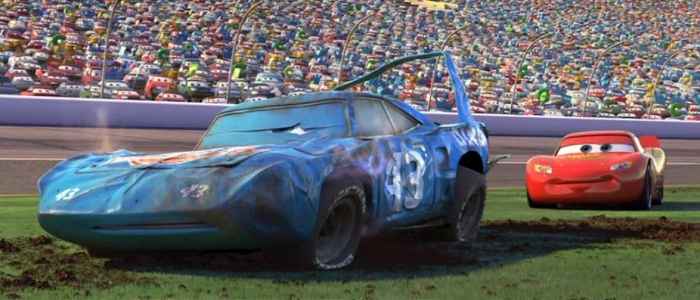
Truth be told, even though it is far from the uneven mess that is Cars 2, the first Cars is still one of Pixar’s weaker efforts, but it nevertheless does have a good moral to its story that comes full circle (no pun intended) by the end of the movie. In this film, hotshot racer Lightning McQueen desires at the beginning of the story nothing less than to win the Piston Cup. Before he partakes in a final tiebreaker race between himself, jealous runner-up Chick Hicks, and retiring veteran racer Strip “The King” Weathers, McQueen ends up having to repair a rundown town, Radiator Springs, that he accidentally damages on his way to the race, and during his stay, he learns humility while living among the residents. Most of this is admittedly fairly standard fare, though this is somewhat elevated by McQueen’s relationship with Doc Hudson, a former champion who left the spotlight after a terrible accident which forced him to retire early.
McQueen does eventually get to the final race against Hicks and The King, and as the race is coming to a close, McQueen is on the verge of victory. The movie could have ended it just like that, with McQueen taking 1st place after learning the humility that comes with victory and overcoming his self-centered behavior to appreciate the people closest to him. However, Pixar took a different approach. In the last lap of the race, Hicks, desperate to not come in last place and lose to McQueen again, knocks The King aside to pass by him, which causes The King to crash in a horrible accident. McQueen sees this and, remembering the images of Hudson’s accident that ended his career, stops at the last moment before crossing the checkered line, allowing Hicks to win the race. In a compassionate move of sportsmanship, McQueen drives back to The King to push him across the finish line to allow him to complete his last race, even though this will dash all hopes of McQueen winning the Piston Cup.
Given that most kids’ films end with the leads being victorious in whatever conflict or contest they are participating in, it is unique to have Pixar deliver a moment where the true victory comes not from being in first place, but from good sportsmanship. Sure, this is a good moral that is often presented to kids during competitions in real life all the time, but surprisingly, it is something that is often easy to forget when watching kids’ films, as the leads almost always come out on top in the end, despite whatever hardships they face in the story. Because of this, it can sometimes give the impression that victory is always important no matter what, and because of that, it is refreshing to see Cars not go for the straightforward first place victory and instead present a more humble message for kids to follow. Sometimes the best victories are the smaller accomplishments that one will feel prouder of, and it is a strong note for Cars to end on in an otherwise familiar story.
The Critic’s Review (Ratatouille)
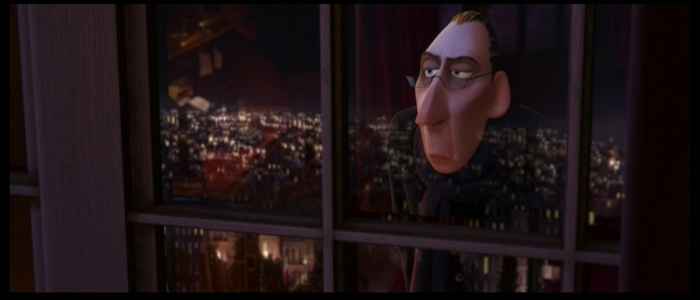
Sometimes it is the simple things that can be most surprising in life. Such is the case in Ratatouille when hardened restaurant critic Anton Ego, who infamously gave a scathing review to Gusteau’s in the past, returns to the place he once condemned when the restaurant becomes famous again under its new chef and owner, Linguini. However, Linguini is almost quite literally a puppet for the real chef of the movie: Remy, a rat who physically controls Linguini to perform cooking by pulling on his hair strings. When the time comes to prepare a dish for the critic, Remy opts for an unusual dish to prepare: ratatouille. Considering that ratatouille is seen as a peasant dish and how high Anton’s standards are, it is a strange meal to prepare for the critic, but they do so anyway. The ratatouille is prepared and served to Anton, he tries it, and lo and behold, the meal is so good that it brings back the memories of his mother’s cooking and causes him to drop his pen, like a large weight holding him down had just been released. He requests to Linguini to meet the chef, and to his surprise, he discovers that the chef is not Linguini, but a rat.
What unfolds next is not only a moment that becomes a strong revelation for Anton, who publicly criticized Gusteau’s belief that “anyone can cook,” but also a surprisingly really deep and touching tribute to artists and critics in general. Anton is not necessarily a villain; just someone with high standards who also wants to uphold said high standards for cooking in general. The aforementioned moment where he eats Remy’s meal and thinks back to his mother’s cooking (a flashback which lasts around 10 seconds) is very short yet says so much about him with so little. He is a person who had a passion for something that seemed almost lost to him until that moment where he discovered that his amazing meal came from a rat of all things. It shakes Anton’s beliefs so much that in his contemplation before the review, he comes to the idea that “the average piece of junk is probably more meaningful than our criticism designating it so.” Now, Anton comes to the conclusion that while he still does not think that “anyone can become a great artist,” he does believe that “a great artist can come from anywhere.”
This moment is a very different scene compared to a lot of entries on this list, but it is a passionate and fairly enlightening look at both the culture of art and the critiquing of it. The film presents a story about a rat who becomes “nothing less than the finest chef in France,” and he succeeds by presenting a peasant dish to the harshest yet most respected critic in France – a move which earns high praise from Anton and warms him in a way he had not likely felt in years. The direction of this sequence is very mature in its contemplative nature about what makes a great artist, and the final message at the end is a very touching one. The film does not try to give the impression that “anyone can cook” like Gusteau said – Linguini presents a perfect example of this – but it does make the argument that it can come from anywhere, even if, as Anton says, “the world is unkind to new talent.” The world is full of critics who will uphold high standards, but also people with great passion who willingly leave their work open to criticism and review, and in the discovery of something special, there are things worth sharing with everyone. The end result is a simple yet passionate exploration of the chef behind the food and the critic behind the review.
Dangers of Consumerism (WALL-E)

Even amongst all of the other movies in Pixar’s unique filmography, WALL-E remains one of the studio’s most interesting creations. It is not every day that you see a film tackle a romance between two robots (with little to no dialogue) along with themes of pollution and excessive consumerism. While the film still managed to earn a G rating, WALL-E is easily the studio’s most mature and adult-oriented film to date, set in a future where humanity has abandoned their planet after excessive consumerism left the Earth unsustainable for life. Despite its dark undertones, WALL-E is still another enjoyable animated masterpiece in Pixar’s filmography – even if kids are less likely to pop this into their DVD than something like Toy Story or Monsters, Inc. – and it tackles a lot of themes that few kids’ films would ever approach to the extent that this movie does.
Pixar has introduced a lot of interesting characters over the years, but WALL-E is still one of the studio’s most unique creations. A small, rusty trash compactor whose years spent cleaning the planet have resulted in the robot developing a personality – one that is innocent, curious, and in need of a companion, which he eventually find when he encounters EVE. Almost the entire movie follows this little robot, but unlike any of Pixar’s other creations, WALL-E can barely speak outside of saying his own name and spouting a few bleeps. WALL-E’s personality (much of which stems from the terrific voice acting by veteran sound designer Ben Burtt) is certainly not devoid of character or charm, but the almost complete absence of dialogue, particularly in the first 30 minutes whose only three characters are WALL-E, EVE, and a cockroach, expects a bit more patience out of younger viewers than the average kids’ film. It was and still is a bold move from Pixar, one that allows the movie to not diminish on its themes in order to appeal more to younger audiences.
In fact, the movie’s message has arguably become more relevant today, with the increased promotion of technology and the Internet taking up a huge part of people’s lives. WALL-E does not present the most positive future for younger audiences; Earth is a desolate landscape of trash, and due to the humans’ prolonged exposure to microgravity, they have become so obese that they need to rely on robots, hover-chairs, and the Axiom’s automated systems to assist them. Face-to-face interactions are done through computers, even when the people talking are literally right next to each other, and they immediately accept any sudden new trends (changing their outfits from blue to red without a second thought) and follow the same daily routine blindly. It is a rather harsh presentation of the dangers of consumerism, especially for a G-rated film, but it is an issue that can already be seen in today’s society and one that has the potential to become worse over time. It is for this reason why having this message in WALL-E is important for younger viewers to see, even if it something that may likely be uncomfortable or dark for them to watch.
Married Life (Up)
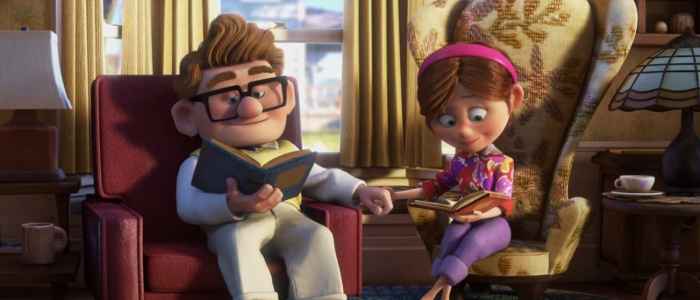
Admit it: when you saw the title of this article and thought about some of the most mature moments in a Pixar film, this was one of the first scenes that popped into your head. And for good reason. Up features one of the most touching, happy, sad, emotional, and perfectly crafted sequences in animated film history – one that is so compelling to audiences that it has even brought many grown adults to tears when watching it. The idea of the sequence is fairly straightforward: it is a 4-minute montage that presents the married life of Carl and Ellie. Their whole life together is explored, from the moment they move into their house, to getting jobs at the zoo, and through numerous everyday activities that they share together. Most of the sequence is actually very happy, and the small gestures subtly and believably captured in the sequence, such as Carl and Ellie reaching for each other’s hand while reading, make for a very believable chemistry.
However, it is not just for those happy moments that people remember this sequence for. Much like Pixar’s prior films, Up does not shy away from the darker and more upsetting parts of everyday life. One of the most emotional scenes happens when Carl and Ellie prepare to have a baby together, only to realize that Ellie is infertile and cannot have children. Suddenly the bright colors are sucked away and the upbeat score by Michael Giacchino becomes slow and somber as the camera pans to a devastated Ellie. One of the most interesting parts of this sequence is how the tone can change from happy to sad in a moment’s notice, which is fitting considering that real life always has its ups and downs, and the film realizes it perfectly. Giacchino’s music is perfect in this sequence, seamlessly transitioning between every dramatic beat, beginning with a lighthearted and enjoyable beat that eventually becomes slower and more sad with every key note as the scene comes to its end with Ellie passing away, leaving behind a grieving Carl to return to his house alone.
The “Married Life” sequence of Up is extremely similar in design to the “When She Loved Me” scene from Toy Story 2 (with the only difference being that Up uses a traditional score instead of a song), and ultimately it works just as well, if not possibly better, than it did in Toy Story 2. With such a short amount of time to cover a couple’s entire life, every moment is carefully selected and detailed with such care that it truly feels like you have experience the life of two people who really loved each other. It is for this reason that this scene resonates so much with people; it feels so intimate and personal that when the inevitable death of a loved one occurs, you feel the same pain that Carl does. For any film in general, it is a great feat to accomplish, but for a kids’ film to create a beautiful and poetic yet ultimately heartbreaking examination of a married couple’s life, it is an extraordinary achievement – one that may even be considered a milestone for what can be accomplished in animated movies.
Andy Says Goodbye (Toy Story 3)
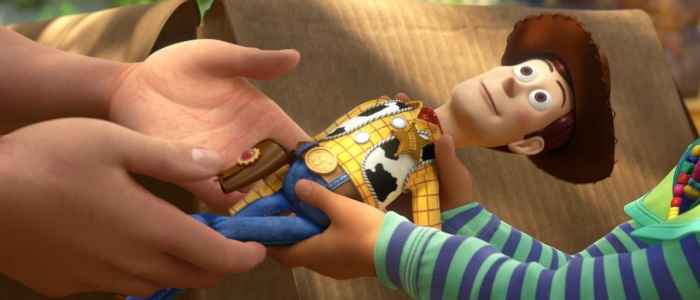
While it may have taken 11 years for Pixar to finally release a third entry to the Toy Story series, Toy Story 3 feels like the culmination of everything that had transpired throughout the trilogy. The last entry in the trilogy, while still filled with the same likeable characters, creativity, and comedy that made its predecessors classics, is a notably darker and more mature entry. If the plot of Toy Story 2 revolved around the toys realizing the fact that Andy will one day grow up and leave them behind, then Toy Story 3 revolves around the toys actually facing that moment and learning to come to terms with it. Indeed, Toy Story 3 is a very bittersweet entry for fans who have ventured into Andy’s room since Pixar’s debut in 1995, and at times it proved to even be fairly emotional for both kids and adults.
There are a couple of emotional scenes in Toy Story 3 that come to mind, such as learning about some of the toys in the last two Toy Story films that have been sold off (Bo Peep and Wheezy among others) and a surprisingly really dark scene where it seems like the toys will meet an untimely demise in an incinerator, but ultimately that is not the scene everyone remembers and talks about. Whether the viewer is 5 years old or 20, almost everyone had a strong reaction to the film’s final scene where Andy gives away all of his toys – including his beloved favorite Woody – to Bonnie. This is the moment that had been built up for over a decade, and everyone knew that this was going to happen, and yet it still managed to bring both kids and adults to tears as Andy says goodbye to Woody and the gang.
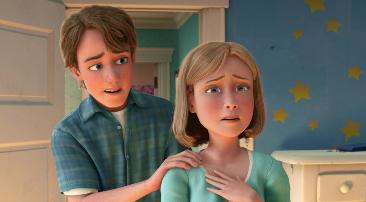
There are several reasons why this scene had such a strong impact on audiences, but if it had to be narrowed down to one thing, it would have to be how it represents the entire trilogy coming full circle. Growing up is a major theme that is prevalent throughout the Toy Story movies, and in Toy Story 3 where Andy is on the verge of leaving for college, it really feels like the story is building up to its end. It is a bittersweet moment that you know is coming, and yet you are not ready to see happen. If this sounds familiar, it is because that is something that happens in real life all the time; all kids do eventually grow up and move on. Before Andy leaves his house, there is a bittersweet moment where Andy’s mom stops for a moment looking at her son’s empty rooms, and she finds herself in tears having to come to terms with the fact that her son is finally grown up and about to leave.
It is for this reason why the ending of Toy Story 3 resonated with so many people; it is not just Andy moving on from the toys, but the audience as well. If you were a little kid when you first saw Toy Story, then by the time you went to see Toy Story 3, you were likely around the same age that Andy was when he was about to depart for college. The experience that Andy is going through is the same one that the audience is: saying goodbye to your closest friends and family. Ultimately the scene is a mostly happy one, as the toys have a new owner who will play with them, but it is also sad when they have to finally accept that it is time for Andy to move on. It is perhaps for this reason that it is a shame that Pixar announced a Toy Story 4, because if the series ended with this scene, Toy Story 3 would be the perfect conclusion to the franchise. Even if that is the case, the final scene of Toy Story 3 struck a major chord with audiences around the world, and it delivered a wonderful send-off to some of the most beloved characters in animated film history.
Mike Realizes the Truth (Monsters University)
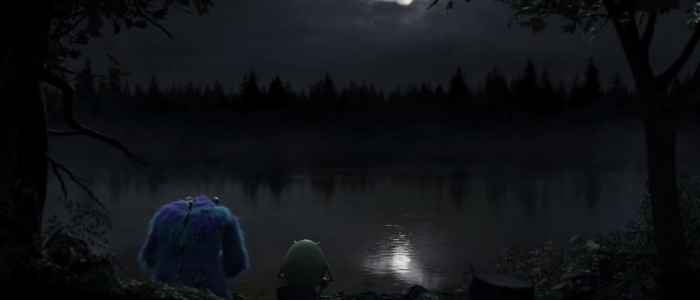
In this moment from Monsters University, Mike, Sully, and their fraternity Oozma Kappa are competing against rival fraternity Roar Omega Roar in the final round to the annual Scare Games. Mike, who is desperate to prove to everyone that he is a scarer, is pitted against the leader of Roar Omega Roar and has to prove his skill through a scaring simulator. In a scene befitting of a crowd-pleaser movie, Mike achieves the best score possible and his team wins the Scare Games. Unfortunately, as it turns out, Mike discovers afterwards that Sully rigged the difficulty settings to Mike’s round the previous night so that his inability to scare would not prevent the whole team from winning. After Mike escapes to the real world to prove his scariness and fails, Sully eventually rushes to bring him back, and the two eventually have a somber and quiet moment together where they express their inner turmoil and reconcile with one another.
This particular moment from the prequel to Monsters, Inc. is actually similar to the aforementioned entry on this list from Cars where the filmmakers took what could have been a familiar but happy outcome and completely turned it on its head. It is often a trope in films such as this that feature a competition and a social outcast trying to prove his worth to have the lead characters triumph in the end in order to provide a happy ending. Monsters University could have easily done just that and everyone watching the movie would have been happy, but much like what Cars did, this film does not opt to do that. The painful truth is that Mike really is not scary, and everything that he worked so hard and passionately on has resulted in a disappointing failure. Every person has had a moment where they worked tirelessly to accomplish something only for it to end in failure; it is another unavoidable part of life where some goals or desires do not always work out in the end. Monsters University tackles this head-on in a surprisingly very mature way where there is no score, very little sound, and a drained color palette; all it features is just two people consoling each other over their failures and struggling to come to terms with it.
However, the film does manage to end on a happy note which in ways provides a more positive message for kids: that sometimes success can be found through failure. While Mike’s original goal did not work out, he eventually finds his calling in life when he helps Sully accomplish massive feats in scaring that he would not have been able to perform alone, which allows the two to become the famous record-setting duo that audiences know from Monsters, Inc. Where most movies opt to always have the lead character succeed as long as he believes in himself or works hard, it is refreshing to see a kids’ film where the message is more grounded in reality but still optimistic. Sometimes the things people work hardest on do not always work out, but there are plenty of possibilities and opportunities for success in other places – some of which can be unexpected. It is an emotional payoff that helps end Monsters University on a high note and reinforce Mike and Sully as an inseparable duo.
Accepting Sadness (Inside Out)
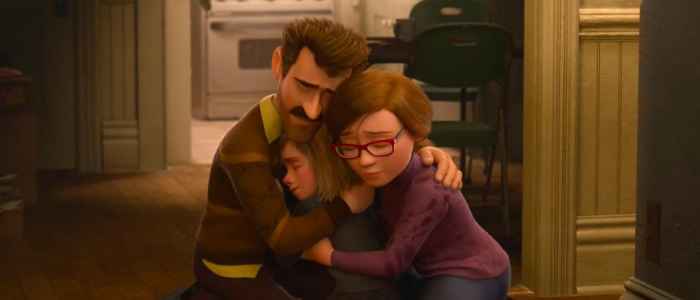
Ending the list here is Pixar’s most recent film, Inside Out, which coincidentally is one of the most emotional experiences that the studio has crafted yet. The premise of the movie follows the inner emotions of 11-year old Riley – Joy, Sadness, Anger, Fear, and Disgust – as she struggles to adjust to her new life when she and her parents move to San Francisco. The major conflict is set forward when Sadness accidentally knocks over Riley’s core memories and causes her and Joy to both be sucked into Riley’s long-term memory. Without Joy at the helm and no core memories, all of the parts of Riley’s personality begin to literally crumble away, and it is a race for Joy to get back to the control center to save her. At face value, Inside Out can be taken as a straightforward adventure film following five likeable emotions as they try to save Riley. However, as one would expect from Pixar at this point, that is far from the case.
Even with an amazing filmography that consists of numerous animated classics such as Toy Story, Finding Nemo, The Incredibles, WALL-E, and Up, Inside Out is one of the studio’s most personal, complex, and endearing movies to date. What appears at first glance to be an adventure story set inside the mind of Riley turns out to be a surprisingly very emotional and psychological exploration of an 11-year old girl on the verge of a breakdown under the stress of moving away from her friends and home. Throughout the movie, Joy tries to keep everything in check so that Riley is always happy – so much so that almost all of Riley’s memories are actually happy. In order to keep Riley happy, however, Joy believes that Sadness needs to be kept at a distance from the control center, believing that it will only cause harm to Riley. However, when Joy becomes trapped inside Riley’s memory dump, where forgotten memories are left to disappear, she discovers a memory that starts as a sad one, but becomes happy when Riley’s parents see her grief and comfort her. Realizing that she needs Sadness to help save Riley, Joy manages to make it back to the control panel with Sadness, who is finally allowed to take control of Riley.
In one of the most humane and personal scenes in a Pixar film, Riley finally breaks down and confesses how she misses her home and her friends, finally allowing her to gain the comfort from her parents that she needed. There have been some very interesting messages provided to kids in various movies – many of which come from Pixar – but the one that is at the heart of Inside Out is possibly one of the most surprising yet mature messages to send to children: that it is okay to accept sadness. To kids, this probably sound ridiculous; who in their right mind would ever to ever feel sad? The truth, though, is that sadness is a part of every person’s life, much like how there is always anger, fear, and disgust. However, there is also joy as well, but that does not mean one’s life can always be happy. There are some rough times before one can be happy again, but keeping that sadness buried inside will only cause more pain. It is a message that is delivered beautifully in the film’s final scene, which feels so emotionally resonant and touching that it connects with anyone who has ever been in Riley’s shoes before.
In many ways, this moment of Inside Out represents perfectly why Pixar is often considered to be the best animation studio around. Not just because of their gorgeous animation, creativity, or even their memorable stories, but for their maturity. Anybody can make a movie with great comedy or beautiful animation, but it takes a special kind of passion to do something much more important: to make the audience feel something when they walk out of the theater. Whereas most kids’ films focus on humor and animation that will appeal to younger audiences while dialing down on any complex ideas or darker elements, Pixar has the courage to not only tackle unique ideas and push the boundaries of what makes a kids’ film, but also broaden their audience’s tastes and beliefs in life and teach them something important. Pixar is the best at what they do because they treat their viewers, young or old, with great respect in order to tell un-compromised stories that have touched generations of people around the world and are hailed as some of the best films of their kind. And for that, moments such as these will live on in the hearts and minds of people everywhere, proving that no film should be devoid of heart or depth just because of its young target audience.
What do you think? Leave a comment.











So depressing! but so well done! I think you were able to capture the essence of each of those scenes and distill it into your article. You don’t realize how many emotionally powerful scenes can be built into “kids” movies but with a comprehensive list like this it really draws attention to the range of emotional experience any audience member can have.
I love Pixar and Inside Out made me love it more. Here’s to hoping we get more moments like these in The Good Dinosaur.
Whew! I went on a ‘feels’ trip reading this article! It’s great to see that Pixar manages to include mature moments in their films, but insert the scene so that it feels organic and relevant for both children and parents.
I especially liked their approach to Monsters University, as I was in university when the movie released. Great work!
If they’re done right animated movies or cartoons are for both adults and kids. Bugs Bunny, a whole different kind of funny now that I’m older.
My two Granddaughters and I loved/love Inside Out.
My wife and I are generally fans of the Pixar movies, we’ve found most of them to be very entertaining even though we don’t have kids of our own. Finding Nemo, Monsters Inc. & WALL-E are among our favorite stay at home on a Friday night fare. HOWEVER, I’ve said for a few years that Toy Story 3 was just not a good movie and always struck me as a cash grab by the principles involved – remember when Tom Hanks and Tim Allen kept saying they were definitely NOT doing a third movie? The Ratso character was nothing short of a pure sadist and I’m glad to see that someone else finally acknowledged that incinerator scene was utterly horrific ( it even gave me nightmares at 40 years old )!
The incinerator scene is much more powerful to me than the ending. The idea of imminent demise surrounded by all of your loved ones who are going to die too is reminiscent of some of the more recent arthouse disaster movies (Melancholia, for one), and pretty intense when it’s beloved animated characters. Last time I watched Toy Story 3 I was folding laundry and pretending not to notice when that scene came on, but ultimately had to answer questions from my inquisitive 5-year old about why they were all just looking at one another and holding hands. Surrendering to the inevitability of death is pretty hard to talk about to a kindergartner.
Up is my absolute favorite Pixar movie and on my top ten list of favorite movies overall.
Monsters, Inc.–the last 10 minutes of that movie kill me EVERY TIME.
“Kitty!”
*sobs*
Pixar is the best movie studio in the US.
Dreamworks is up there too.
These moments, though very mature for some audience, balance out the movie’s humor or comic relief. These are well done, but it should be considerate of all audience. Great article – it has a new viewpoint.
Pixar is always for grown-ups.
Pixar films are the only animated ones I enjoy. And these examples are some of the reasons why.
I cry at everything.
Not such a big fan of Inside Out. The story is fine but the animation felt lazy and flat. Every one of those characters has been drawn before. There were so many opportunities to make this a visually rich and more mysterious film but instead it lacked originality in the illustration, especially of the emotions.
Pixar are masters of this stuff. I can admit I’ve wept at many of these moments, hah hah.
Fabulous movies.
I’d say that Ratatouille as a whole was the most adult of the Pixar films, due to it’s storyline and lack of child characters. The first third of Wall-E is equal to the greatest films of the silent era. And I totally had something in my eye watching Carl and Ellie’s story…
Movies written by and for people who have spent a LOT of time in therapy. Only Steve Jobs could have seen the lucrative potential of animating a character’s journey through the rifts and valleys of his own navel.
I love Pixar. Yes I’m 48 yrs young, I LOVE PIXAR.
Can we talk about Lava? Or any of the other shorts? Pixar has tremendous storytellers.
Lava was beautiful. Totally agree.
Lava is beautiful – I just saw that the other day for the first time. I’d love to see an article about Pixar’s shorts. Hmm…
I knew Up had to be something special when my 20 year old son (very masculine hockey player) came home from the movies with tears in his eyes, saying, “Mom, it’s the best movie I’ve ever seen.” He was right.
I dare anyone to watch the accepting sadness scene in Inside Out without getting teary eyed. It is a beautiful scene that establishes a lesson even adults take for granted. Bottling up sadness is unhealthy because avoiding a problem, what ever it may be, will never cause it to go away. I know when i’ve gone through depression, I felt every day just got bleaker and bleaker. Then when I finally poured out all my emotions, it was like a weight was lifted. That why Inside Out is my favorite Pixar movie.
I agree with most, if not all, of the examples brought down in this article. The genuine pathos that Pixar is able to evoke is nothing short of astonishing. The only film studio that I would consider comparable is Ghibli, especially Miyazaki’s films.
honestly feel like Pixar is the greatest movie studio out.
I cried at the end of Monsters, Inc.
UP and Toy Story 3, I feel such sadness just thinking about them. Real life, so real!
Just because it’s an animated movie doesn’t mean it’s a “cartoon” for children.
Up is my favorite Pixar movie for so many reasons! My husband and I tried for 12 years before we finally became pregnant through fertility treatments. Unfortunately we lost our baby and the day I came home from the doctors office, I crawled into bed and turned the tv on… Up was playing and it had just started. Needless to say I cried my eyes out for the rest of that day. I still haven’t been able to watch it since.
I remember seeing Toy Story 3 and weeping and weeping at the bit where ‘Big Baby’ is on the swing looking up at the moon. Awful!
Hated Wall E. I took my son to it and hated it. It had it’s entertaining moments. My son was maybe in early middle school, so not a squirming tot. What I hated was the preachy message throughout, that his planet and his future are doomed by our (and his) disposable lifestyle.
Same reason I stopped watching nature shows. The first half is about the animals and nature that I want to see. The second half is about making everyone feel guilty about being humans.
like it or not, we are dooming this planet with our disposable lifestyles. Many of the animals in those nature shows will probably only be seen in videos and zoos within your lifetime let alone your son’s lifetime. The reason why they keep hammering that message is exactly because of people like you who willfully cover your ears and hum loudly when people dare to speak about the damage we are doing. You are either part of the problem or part of the solution and it seems clear what path you’ve taken.
I actually found the message of Wall-E to be very uplifting in the end! If you watched right through to the end, you’d see that the environmental part of the message was actually that the Earth needs people to not give up on it. (SPOILER ALERT, don’t keep reading if you haven’t seen it) The captain of the Axiom makes the decision to turn the ship around, to go back to Earth because of E.V.E.’s discovery, despite the decision his predecessors made to abandon earth entirely. They all go back and work to make it better, and they succeed. The movie was itself about how “irrational love defeats all life’s programming” (Andrew Stanton, Director https://en.wikipedia.org/wiki/WALL-E#Themes)
Great movies for all!
“Inside Out” is fairly “Up”-like. The adults appreciate it more than the kids.
I am traumatized for life at the opening sequence of Up!
No its the part near the end when he’s finally made it to the falls and he’s looking through her adventure book and discovers all the pictures she’s added over the years and the very last thing she writes is “thanks for the adventure, now go have a new one.” and I cry like a baby every. single. time.
We really enjoyed Inside Out, but it didn’t make any either of us tear up. The only one of those that did was the reflection of the spouses life in Up.
I don’t think adults need to reevaluate Pixar, most are already huge fans.
My daughter and her husband saw Inside Out. They have a 21/2 yr old son. The scene when baby Riley runs through the house naked made my daughter and SNL laugh hysterically. They both yelled ‘Yes!!! Exactly!”
Up caught me completely off guard the first time I saw it. Took the family to the theater and spent a good part of it pretending there was something in my eye.
Very good story and beautiful scenes.
Up is a devastatingly beautiful film
If you don’t cry in the first 10 minutes of Up, you’re dead inside.
Pixar is not for the light-hearted.
I’ve always been fascinated with Pixar’s ability to appeal to adults’ emotions while still remaining lighthearted enough for kids. I know everything flew over my head when I was a kid, and it seemed super weird to me that my mom couldn’t watch more than ten minutes or so into Finding Nemo because it upset her too much.
This was a wonderful article to read! I have to say that I more or less agree with all of your top picks, even reading about some of them can spark emotion in me.
Pixar’s work is truly amazing, there’s no doubt about that. Up and Inside Out are definitely among some of their strongest works emotionally. It’s fascinating how mature it can handle its content, and how impactful their storytelling can be. Inside Out for example is already being used to help younger children understand mental health disorders and the like. The balance that the studio has accomplished is impeccable.
Though I am curious: Among all the studios you listed, you left out Dreamworks, the second largest computer animated movie company, is there a reason why? Don’t get me wrong, I would agree that of the two Pixar’s work is definitely more solid, but Dreamworks has done some great works with mature themes and moments as well. I suppose a difference would be that while most of Dreamworks’s movies are good, only some are typically great, and some can be pretty bad, while Pixar really only has Cars 2 and then a few ‘weaker’ movies. That being said though, I don’t think the studio deserves to be ignored. Something like How to Train Your Dragon, Rise of the Guardians, or even Kung Fu Panda can have really amazing moments that can address both younger and older audiences. So there’s a lot to be offered there as well.
Don’t get me wrong, I do understand that this article is about Pixar movies, I’m not suggesting it should have been otherwise. But I do think that Dreamworks shouldn’t be ignored in the conversation of great movies, or that it should be said that Pixar stands totally alone.
That being said, I’m wondering if you’d be willing at all to do another article exploring some of Dreamworks’s more mature and impactful films? It’d be great to see you cover it.
I left out Dreamworks for two reasons. The first was because I wanted to focus solely on Pixar’s movies, which is why you do not see anything from other studios like Studio Ghibli or Dreamworks. The second is because while Dreamworks does have its share of great mature moments, I personally believe that Pixar is more consistent at delivering these kinds of moments.
That is not to say I do not like Dreamworks. While I do not think everything is memorable (Shark Tale and Turbo for example), they have recently made some really great films, such as Kung Fu Panda and Rise of the Guardians. The How to Train Your Dragon films in my opinion are the best thing they have done since Shrek.
Personally, I prefer most of Pixar’s films to Dreamworks, but I do agree that Dreamworks has some great stuff to offer. I only left Dreamworks out of the article so I can focus on Pixar’s work. Maybe one day I might cover some of Dreamworks’ movies in another article.
Implying animation is just for kids makes as much sense as saying live-action is just for adults. If a film speaks to you and connects with you, that’s all that matters.
Great heartwarming moments in Pixar’s history!
I definitely find the best impact a film or any work of art can make is spanning a whole range of emotions (and Inside Out is a perfect example, haha), the sadder we are, the happier we’ll be. I think Pixar is continuing a trend started by the great Don Bluth: go dark and make the characters have to suffer to enjoy the sweetness of the victory that comes. Granted Bluth went further with the idea than Pixar has, but I hope the trend of exploring the dark issues kids face today will continue to bravely shine light through media on how to understand those young minds most of us left a long time ago.
The most adult moment in Up is the montage in the opening (Ellie’s miscarriage) and actually the most adult moment in all the Pixar films.
My husband and I first watched it when we had been trying for years to have a baby. That was very hard. Fortunately, both had a happy ending!
Lovely list. I think the beauty of Pixar is that there are several other moments you could have included. This is not a failure on your part but speaks to the depth of their plots. I think that Pixar has continued to be respected without the ups and downs of other animation studios because of these moments. While they make me cry, I would rather cry than be numb. Thanks for the list!
Excellent article! Pixar is perhaps my favorite animation studio, and I think your analysis highlights what makes them great. Very few movies make me cry: Inside Out made me cry.
Pixar may well be my favourite film companies because of thier ability to mix in the light-hearted humour with more sombre, serious and emotional elements. Wall-E and Up were just brilliant at doing this.
The first 10 minutes of UP had me crying like a baby! it really hit the emotional spot in me.
I cried during UP.
Really interesting article that manages to be different to all the other articles that have been written about Pixar on this blog! I like how you take individual sequences and analyse their emotional level, and how they deal with themes like personal development, growing up and social concerns, things that we are confronted with every day. Pixar films should never be considered as ‘children films’ – they reach to both a young audience and a more mature audience, which is really the key of their success.
The Toy Story movies definitely have more depth than one would expect.
You’ve perfectly captured all of the saddest and most heartwrenching moments throughout all of Disney. Thanks for the tears.
If a movie can leave me in tears, then something right is being done. I’ve come to expect being moved emotionally now by Pixar, but no one would expect it at first when Toys Story came out. Ever since then, I feel like my heart is ripped out whenever a death or sad theme occurs. Great animation and a great story is what Pixar is the best at.
These were all such powerful moments in Pixar’s history, and I remember each one of them and the impact they had on me when I saw them for the first time. They’re so memorable and impossible to forget, which just goes to show the absolute brilliant storytelling abilities Pixar possesses.
I have always been fascinated by Pixar as a child and as an adult. The one thing that keeps me interested as an adult is the emotion behind stories. I saw UP as an adult, I remember it bringing me to tears because they really touched on the tragedy of losing a loved one. Another animated film that I really love is called Coraline it is not by pixar, it was directed by Henry Selick. To me the movie was targeted toward older children, it was a thriller that I could imagine being a little to freaky for children under say 6 years old or so. But the film was about a little girl, whose parents are both writers and extremely busy. She becomes bored and resentful and she finds this parallel universe, I won’t say to much as to not spoil but I remember being really impressed by not only the art but the way the story tellers really pin pointed what it is like for a child to grow up when both parents work and you feel sort of invisible. I watched the movie as an adult but still was moved by it more than being moved by movies with real people and real actors….
I really do agree with the content of the article. There is a lot of heart and soul in the stories that Pixar has created over the course of its establishment. However, for someone with a different cultural background you start to wonder if you can even relate to these stories. It is disappointing not seeing more representation in the animated industry because we are a indeed a very diverse group of people. I mean, kids are brighter than we give them credit for and over time are going to realize just how little of themselves they see. Pixar movies have such universal messages that for one reason or another can only be told through a certain lens and that needs to change.
I think this has probably been one of the most fair and critical articles about Pixar I have read to date. I think the examples and arguments brought up by the author were not only well articulated, but on the spot. The article captures the essence of why we love Pixar’s stories and the way’s in which they captivate audiences of varied ages.
Pixar continues to draw in a wide range of people to see its films and this article proves why. Its storylines can conjure up memories and feelings felt by adults as well as children.
Great article capturing some of the best little moments, coincidentally i’ve been going back through some of these classics and finding it funny how I connect more with the film now that I understand these more adult quips compared to when I was a child.
Beautiful article…it managed to bring me right back to each of these moments from their respective films, and it hit me almost as hard as the first time around. Pixar has this magical way of storytelling that crosses boundaries like no other, and with these scenes it is made clear – I can’t wait to see the progression of Pixar even further with any new films they decide to put out.
This is great. Pixar is fantastic at storytelling, especially in cases of mixing humor with serious undertones. Plus, who hasn’t cried at a Pixar movie. Fantastic job of compiling some of those key moments!
This is a fascinating analsys of the detail in Pixar movies. My favourite is still The Incredibles.
When I saw the title of your article i shuttered a bit. There’s been a trend in movies and other forms of media that pits “maturity” as simply being sad. By having sad events or themes something is considered more mature and for a more adult audience. It immediately gives a lot of problems a pass it’s something thats been really annoying me recently. There’s so much more to adulthood (and life in general) than sadness. Growing up is a series of highs and lows as your life changes drastically, but directors and authors often just stick a dead parent or a destroyed object into the story and bam its mature.
Thankfully this list does a better job than most of looking at all aspects of maturing. Not just the sadness but the happiness, the changes, the understanding of where you fit into the world and how the world reacts to you. Pixar often does a good job of showing this side of growing up and its nice that its getting that acknowledgement here rather than simply a list of sad “feels” moments.
This idea is something I think goes unseen by many viewers of Pixar movies. Pixar has been known to write amazing stories and if you look deeper and watch closely to all of the movies, we see many moments where mature adults can connect. It is one of my favorite things about Pixar movies.
Really intriguing! I literally just finished watching Inside Out when I read this, and even being a university student (just moved out) I totally relate to the emotions conveyed in the story.
In a way, though, I don’t agree that these moments are “mature” – I’d sooner put them under a category with a name more along the lines of “when pixar gets very real”, because it’s so easy to disappear into these “kids” movies. When they bring to light real life struggles, it intensifies our emotions towards the characters and the plot.
This was a wonderful detailed article. I agree with all of your parts. I like how Pixar likes to toy with darker themes and make them easier for children to understand. These emotional parts are important to show to kids. They can learn from these movies about the emotional parts of life.
I was indeed the same age as Andy was in Toy Story 3, so the full circle the movie comes to connected with me on so many levels. The writers could’ve easily kept Andy the same age as he was in the first Toy Story and kept the toy hi jinks the main focus, but that would’ve cheated the audience who had grown up with these characters. Saying goodbye to the toys you loved as a kid means saying goodbye to your childhood, and Toy Story 3 captured that feeling of excitement and anxiety perfectly.
Excellent subject matter–the title was attention-grabbing and the content was satisfying. I loved the choices of “mature moments”, specifically from Inside Out, Toy Story (Jessie) and Up. Many people like to write off these animated films because of the intended audience, and assume that they hold no meaningful value, which we learn is not the case; well done, and fair points made!
Spoiler Alert! When those toys were sliding down the trash pile into the saralacc pit of fire I remember my heart beginning to beat fast, my palms began to get sweaty knee began to bounce. I moved from leaning back in my chair to the very edge of my seat. But as soon as the toys grabbed hands and closed their eyes to meet their impending doom, I felt my eyes turn hot and my vision go blurry. And there I was a 20 year old man crying and the sight of toys being thrown away. But it was so much more than just toys. They were my toys. I played with Buzz Lightyear and Woody. I remember making woody ride Rex the Dinosaur and Buzz fly through space. I remember making slinky chase Woody and Buzz until they were all out of breath so they had to catch a ride on RC the remote control race car. They were my toys. My eyes were swollen with tears not only because of the emotions they withdrew within me but because of the memories they expelled and reminded me that long ago, I gave up these same toys to grow up and get a job and pay bills and get a girlfriend. I lost the toys I loved to gain something else that I soon realized I didn’t want.
This article was fantastic and reminded me that Toy Story is one of the best movies I have ever seed. I think I’ll pull out my old Buzz Lightyear and…take a look at it for a while. Thanks
I appreciate your choice of topic. It seems that pre-2000, there were plenty of child-geared films that addressed heavy or dark subject matter (and also appeared to adults). Then all of a sudden, films for children were watered down and relied on bathroom humor and slapstick for appeal, quickly losing adult interest.
Taking that approach assumes that children are not capable of processing difficult subjects or that they are too vulnerable to be exposed to it, when in reality, they are exposed to it everyday at home and could probably benefit from seeing a film that addresses those subjects. Adults can identify with the film’s content and the child’s response, and use that potentially upsetting moment as a learning lesson.
Awesome topic. Many of these scenes are tearjerkers, but it’s an indication of powerful storytelling on Pixar’s part. It’s also intriguing how some of their movies, such as Finding Nemo and Up, start off with the somber beginnings.
I may not watch a lot of Pixar movies, but these moments remind me why I love those movies. It takes situations and takes to kids about it at their level without talking down to them.
I loved that Inside Out was a kid’s movie so parents would have to go with their children. It let kids know that it’s okay to be sad, and let parents helped parents recognize the realities of places expectations on their children.
What a great article! So well written and thoughtful, and it mentions so many great films and great moments therein. I haven’t seen Inside Out, and knew this would be somewhat of a spoiler for me, but it was worth it (but thank you for not saying more than you did!).
Lovely article! The beginning scene of ‘Up’ was definitely a tear-jerker.
Inside Out was quite a moving film that brought me to the brink of tears multiple times. As a young adult who recently exited the dramatic teenage years, Pixar really struck home with a film that revolved around a dynamic family environment, the fight for independence, loss of childhood wonder, and finally – finally! – the joy of forgiveness, redemption, and understanding (sorry if that got sappy).
Absolutely loved your article, thanks for taking us on a trip down Pixar’s memory lane.
I’m a grown woman, but I still enjoy animated movies like Pixar’s because, as this article indicates, there is so much depth. I love the “accepting sadness” moment in Inside Out. As for the scene where Marlin names Nemo, I’m okay with the actual naming part. But when Marlin holds the little egg in his fin and says, “Daddy’s got you,” it just tears me up.